
Leucopogon gibbosus is a species of flowering plant in the heath family Ericaceae and is endemic to the south-west of Western Australia. It is a shrub with more or less round leaves and spikes of tube-shaped white flowers on the ends of branches and in leaf axils.
Conostephium drummondii is a species of flowering plant in the family Ericaceae and is endemic to the south-west of Western Australia. It is a slender, erect or spreading shrub that typically grows to a height of 0.3–1.5 m. It is a variable species with multi-coloured flowers from March to July or from November to December.
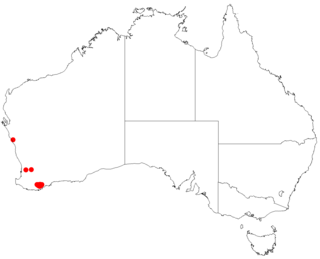
Leucopogon atherolepis is a species of flowering plant in the family Ericaceae and is endemic to the south-west of Western Australia. It is an erect shrub with linear leaves and white, tube-shaped flowers.

Leucopogon compactus is a species of flowering plant in the heath family Ericaceae and is endemic to the south of Western Australia. It is an erect shrub with oblong leaves and dense clusters of white, tube-shaped flowers.
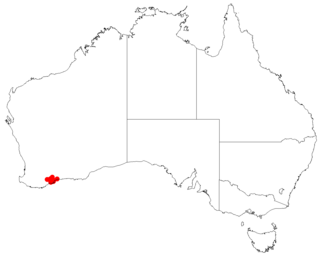
Leucopogon decussatus is a species of flowering plant in the heath family Ericaceae and is endemic to the south-west of Western Australia. It is an erect shrub that typically grows to a height of about 40 cm (16 in). It was first formally described in 1859 by Sergei Sergeyevich Sheglejev in the Bulletin de la Société impériale des naturalistes de Moscou. The specific epithet (decussatus) means "decussate".

Leucopogon fimbriatus is a species of flowering plant in the heath family Ericaceae and is endemic to the south-west of Western Australia. It is a bushy, erect or sprawling shrub with overlapping egg-shaped or oblong leaves and spikes of tube-shaped white flowers on the ends of branches.

Leucopogon gilbertii is a species of flowering plant in the heath family Ericaceae and is endemic to the south-west of Western Australia. It is a slender shrub with linear to lance-shaped leaves and spikes of tube-shaped white flowers on the ends of branches and in leaf axils.

Leucopogon lasiophyllus is a species of flowering plant in the heath family Ericaceae and is endemic to the south-west of Western Australia. It is an erect shrub with linear to lance-shaped leaves and small, dense spikes of tube-shaped white flowers on the ends of branches and in leaf axils.

Leucopogon lasiostachyus is a species of flowering plant in the heath family Ericaceae and is endemic to the south-west of Western Australia. It is an erect shrub with egg-shaped to lance-shaped leaves and dense, cylindrical spikes of tube-shaped white flowers on the ends of branches and in leaf axils.
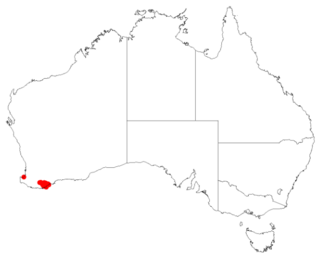
Leucopogon penicillatus is a species of flowering plant in the heath family Ericaceae and is endemic to the south-west of Western Australia. It is an slender, erect, spreading shrub with egg-shaped to narrowly triangular leaves and white, bell-shaped, bearded flowers arranged in groups of between 3 and 13.
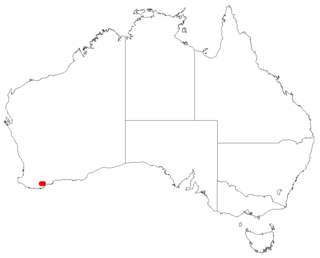
Styphelia psilopus is a species of flowering plant in the heath family Ericaceae and is endemic to the Stirling Range in the south-west of Western Australia. The species was first formally described in 1859 by Sergei Sergeyevich Sheglejev who gave it the name Leucopogon psilopus in the Bulletin de la Société impériale des naturalistes de Moscou, from specimens collected by James Drummond. In 2020, Michael Hislop, Darren Crayn and Caroline Puente-Lelievre transferred the species to Styphelia as S. psilopus in Australian Systematic Botany. The specific epithet (psilopus) means "glabrous foot". It is listed as "Priority Two" by the Western Australian Government Department of Biodiversity, Conservation and Attractions, meaning that it is poorly known and from only one or a few locations.
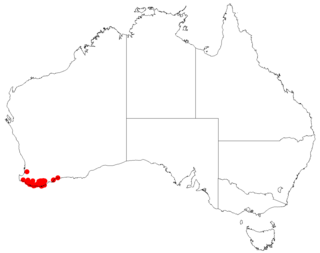
Leucopogon unilateralis is a species of flowering plant in the heath family Ericaceae and is endemic to the south-west of Western Australia. It is a shrub with oblong leaves and spikes of white, tube-shaped flowers arranged in small groups on the ends of branches and in upper leaf axils.

Styphelia erectifolia is a species of flowering plant in the heath family Ericaceae and is endemic to the south-west of Western Australia. It is a shrub with often wand-like, erect or ascending, usually softly-hairy branches and a thick, woody trunk. The leaves are linear, tapering to a short point, the edges turned down or rolled under and usually less than 12 mm (0.47 in) long. The flowers are red, and nearly sessile, with bracteoles about 2 mm (0.079 in) long at the base. The sepals are about 6.5 mm (0.26 in) long, the petal tube 8.6–11 mm (0.34–0.43 in) long with lobes 4 mm (0.16 in) long and bearded inside.

Styphelia lissanthoides is a species of flowering plant in the heath family Ericaceae and is endemic to the south of Western Australia. It is an erect, bushy shrub with egg-shaped to lance-shaped leaves with the narrower end towards the base, and white, tube-shaped flowers arranged singly or in pairs in leaf axils.
Styphelia lanata is a species of flowering plant in the heath family Ericaceae and is endemic to Western Australia. It is a shrub with wand-like branches, usually covered with loose, soft hairs, the leaves linear to lance-shaped about 12 mm (0.47 in) long, and white, tube-shaped flowers with small bracts and bracteoles. The lobes of the petal tube are bearded only at the base.
Acrotriche parviflora is a species of flowering plant in the family Ericaceae and is endemic to the south of Western Australia. It is an erect, spreading or compact shrub, with oblong to narrowly egg-shaped leaves, and green, tube-shaped flowers.

Andersonia axilliflora, commonly known as giant andersonia, is a species of flowering plant in the family Ericaceae and is endemic to southern Western Australia. It is an erect, rigid shrub with glabrous, lance-shaped leaves and creamy-white flowers.

Andersonia echinocephala is a species of flowering plant in the family Ericaceae and is endemic to the south of Western Australia. It is an erect, rigid shrub with lance-shaped leaves and heads of up to 15 or more, white or cream-soloured flowers.

Andersonia grandiflora, commonly known as red andersonia, is a species of flowering plant in the family Ericaceae and is endemic to the south-west of Western Australia. It is a prostrate cushion shrub with lance-shaped leaves and groups of two to four reddish orange, tube-shaped flowers.

Andersonia simplex, commonly known as spiked andersonia, is a species of flowering plant in the family Ericaceae and is endemic to the south of Western Australia. It is an erect or ascending shrub, usually with ascending branches, pointed lance-shaped or egg-shaped, sometimes twisted, wavy leaves, and pink and blue, purple or reddish-purple flowers.



















